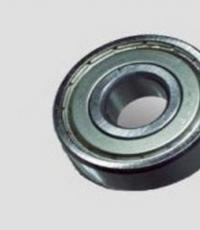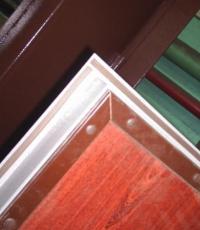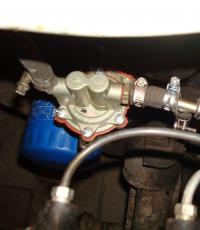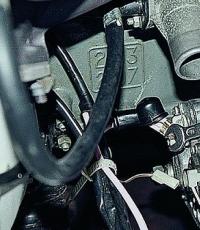Inner CV joint VAZ 2110 - do-it-yourself diagnostics and repair
Inner CV joint VAZ 2110 or constant velocity joint , or popularly "grenade", is an integral part of the transmission of a front-wheel drive car.
Its main role is the continuous transmission of rotation from the gearbox to the wheels at different angles. Despite the same principle of operation of all CV joints, they differ in design features for different car models. In addition, different operating conditions cause differences in the design of the external and internal CV joints.
The CV joint performs an important function in the car, it consists of seven parts:
- Retaining ring.
- Balloons.
- Separator.
- The boot, which is listed in the technical manual as a bellows.
- Frame.
- drive shaft.
- Inner rim.
The VAZ 2110 drive unit is responsible for transmitting torque to the wheel from the gearbox. The CV joint allows the front wheelset to perform turns by normalizing the changing angle between the axle shafts. There are two grenades in the device of the machine: the outer one transmits rotation to the hub, and the inner one is needed to transfer rotation from the gearbox to the shaft.
Where is the inner CV joint VAZ 2110
It is easiest to see it from the bottom of the car, by the way, you will have to remove it by crawling under the bottom, although you can do without it (For example, you can put planks under the front wheels and raise the front part with two jacks, provided that both jacks will stand on these planks, thereby before it will be higher, this is especially convenient if the car is high), but it’s still better to drive the car onto a lift and replace the CV joint you need with a new one, but we’ll immediately explain to you what the outer and inner CV joints mean so that you understand this and don’t get confused (It's just that in the article we will often talk about them and so that you immediately realize what kind of CV joint we are talking about), so the outer one is the one that faces the car wheel and is inserted into the hub (Both outer ones are indicated by green arrows), and already the inner one is the one that is inserted into the box (They are indicated by yellow arrows) and there are four total CV joints in front-wheel drive cars, two of them are located on the left side and go to the left wheel, and the others there are two on the right and go to the right wheel, but there are only two drives on which the CV joints are installed, and both of them are indicated in the photo by blue arrows.
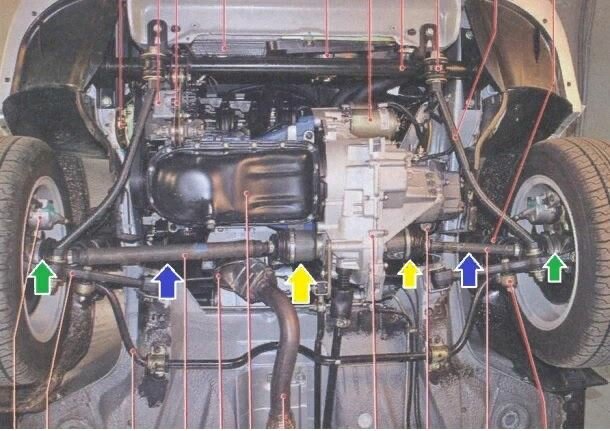
The location of the inner and outer CV joint VAZ 2110 is indicated by arrows
Diagnostics and troubleshooting of the internal CV joint VAZ 2110
If you constantly pay attention and monitor the internal CV joint, then it will quietly serve 150-200 thousand km. Otherwise, malfunctions may appear already in the first hundred thousand km.
The main enemies of any hinged mechanisms are dust and dirt, which play the role of an abrasive and accelerate the wear of the grenade. It is worth the car owner to miss the damage to the elastic cover and drive for some time without replacing it, as the same dirt gets inside, which sooner or later will do its job, even if you change the boot.
There are other reasons leading to malfunction and replacement of elements:
- there is not enough lubrication in the mechanism or its quality leaves much to be desired;
- too aggressive driving on bad roads, constantly creating extreme loads on the CV joints;
- factory marriage in the details of the assembly.
Conclusion: most of the causes can be foreseen and prevented with the help of prevention, postponing the replacement of grenades indefinitely.
If during the operation of the VAZ 2110 car the following symptoms of a malfunction appear, then additional diagnostics must be carried out:
- while cornering, a characteristic crispy sound is heard from the front of the car, as if during operation, steel balls touch the body;
- the same, only instead of a crunch, a knock is heard, it can disappear during rectilinear movement;
- a constant crunch that does not disappear when driving in a straight line indicates wear on the internal grenade.
Remember that after the appearance of such noises on one side or on both, it is impossible to immediately delay the repair. Otherwise, a faulty CV joint can do a lot of trouble right on the go.
To make sure that the grenade is broken, you can check it in 2 ways:
- Choose a flat area so that there is enough space for the Niva to turn around. Make a few circles on it for and counterclockwise, turning the steering wheel all the way. Listen carefully for the sounds that come up. If they look like a crunch, go to part 2 of the diagnosis.
- Install the machine above the inspection hole and check for play in all 4 nodes by manually swinging and turning the axle shaft in different directions. A worn hinge will immediately make itself felt.
- If at the same time it was found that the anther was damaged or water was flowing out of it, then the CV joint in this place must have become unusable.
Now let's talk in more detail about the backlash in the ball bearings. The backlash resulting from the wear of the support will also negatively affect the condition of the CV joint. And if, when driving at speed, the pin of the ball joint is pulled out of the mount, the inner CV joint can generally be broken. By the way, all the main blows of fate are taken by external grenades. And this is due to the fact that they are connected through the hub to the wheel. It is from the wheel that the CV joint receives powerful shocks and shocks. Yes, and water with mud from under the wheels gets faster and more on the outer CV joints. Therefore, in order to damage the CV joint, which is connected to the box, you need to try. An exception is the situation when the pin of the ball joint is pulled out.
Inner CV joint VAZ 2110 - do-it-yourself step-by-step instructions for replacing
Before you start work on self-replacing the internal CV joint VAZ 2110, you need to prepare everything.
To do this, you need to fix the car, turn on speed 4, tighten the handbrake. Secure the rear wheels with wheel chocks. If they are not available, use bars of a similar shape. Remove the protective cap, unscrew the hub nut with a “shoulder” (extension) - a pipe or a mount. After the hub nut is removed, unscrew the wheel bolts.
Let's move on to the step-by-step instructions:
- Jack up the wheel on which the CV joint is to be replaced.
- Unscrew the bolts to remove the thrust washer of the hub nut.
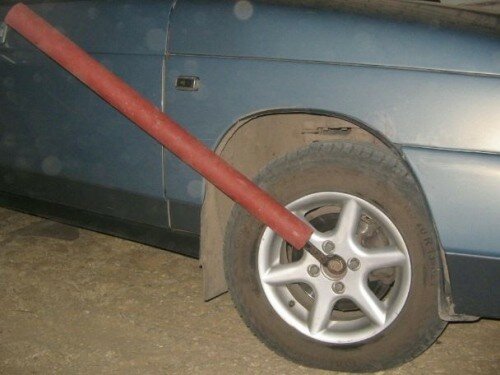
- Remove the 2 bolts that secure the lower ball joint of the steering knuckle.
- If the CV joint is replaced on the right, turn the steering wheel to the maximum to the left, and if on the left, then to the right.
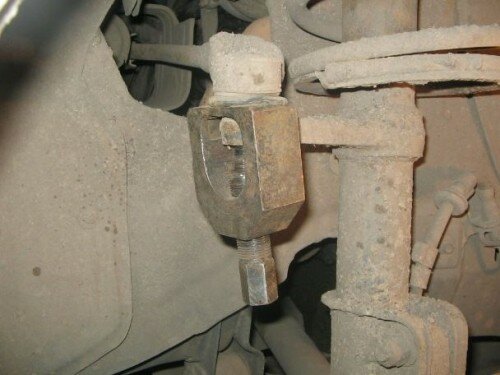
- Pull off the steering knuckle and strut. Remove the splined end of the outer CV joint from the hub.
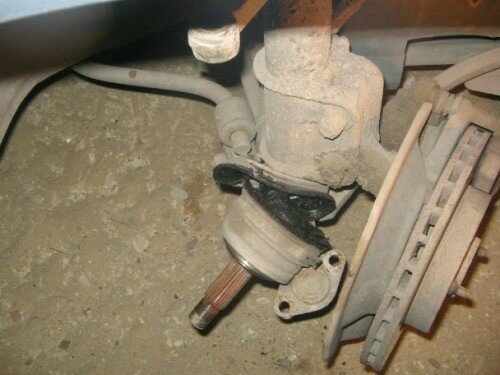 Use a pry bar to remove the inner joint from the gearbox.
Use a pry bar to remove the inner joint from the gearbox. - Fix the drive shaft in a vise, remove the clamps from the outer and inner CV joints. Turn the anthers inside out. If they are torn or cut somewhere, you can simply cut them off with a knife.
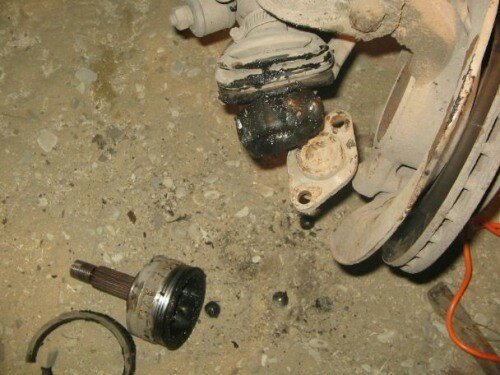
- Dismantle the CV joint VAZ 2110 from the shaft. You can use a hammer and a wooden or bronze tip.
- Assembly is carried out in the reverse order. At the same time, install a new hub nut. At the end of the tightening, you need to tighten its edge to avoid unwinding.
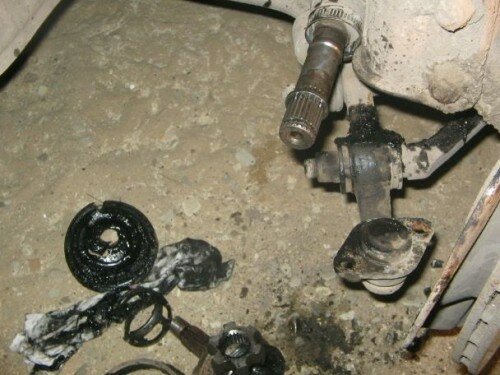
- When installing the inner CV joint, a plastic plug is placed on the end of the shaft.
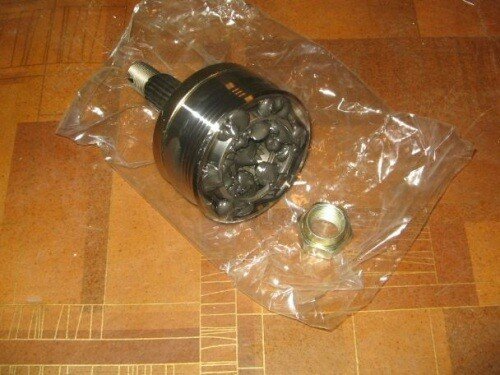
- Before you put the CV joint VAZ 2110, you need to make sure that a sufficient amount of lubricant has been applied. Install the retaining ring on the inner CV joint.
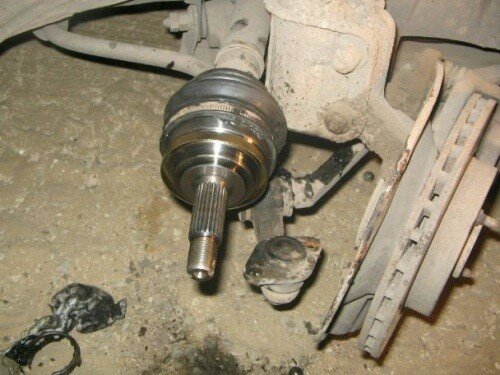
- After the drive is put into the box, put it in the side gear so that it is completely fixed. This can be done by lightly tapping with a hammer on the surface of the wooden adapter around the entire perimeter of the shaft axis.

